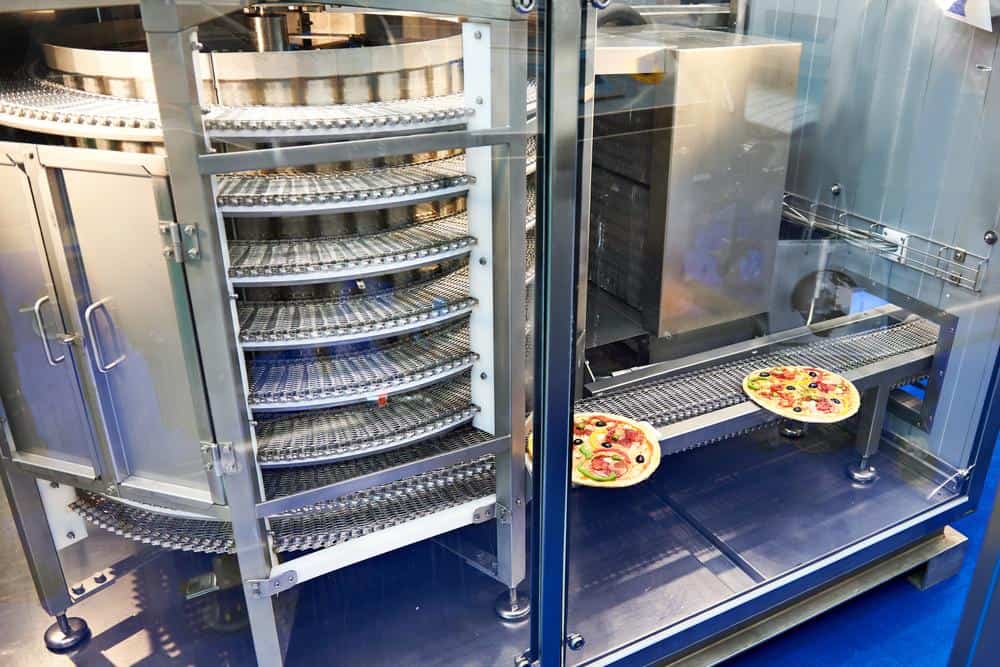One type of freezer that is quite popular with growing business owners is the spiral freezer. But it’s not the best solution for every company, so understanding its functions can help decide whether this freezer is suitable for their needs. One of the hallmarks of a serial freezer is efficiency, which we'll expound upon below.
Continue reading to learn:
Spiral freezing is a freezing method that employs refrigerators that are able to cool a large amount of products in a reduced space maintaining the quality. It also has the advantage of refrigerating the products evenly due to their design.
Spiral freezing allows business owners to maintain the moisture, flavor, and texture of certain products like ice cream, frozen pizza, and more during the freezing process.
Spiral freezers typically use cryogenic or mechanical refrigeration methods. Additionally, high-velocity air is pumped over the product either vertically (downflow) or horizontally (crossflow).

A spiral freezer
A cryogenic spiral freezer features a conveyor belt that travels vertically in a spiral. This method succeeds in maximizing cryogen use and saving floor space.
The liquid gets injected into an individual zone of a standard cryogenic freezer. To envelope the food product altogether, the cold vapors go to the ends of the freezer. Liquid nitrogen or carbon dioxide may be the better choice for the application, depending on several different variables.
When you freeze a product, the primary goal is to conserve and extend its shelf life. For that, there are several ways to freeze a food product and multiple coolants used in the industry.
The freezing system utilized is generally cryogenic or mechanical. Mechanical is when the freezer uses a refrigerant that circulates throughout the freezer to lower the air temperature, or a liquid passes over the food.
A cryogenic freezing process entails using air products such as carbon dioxide or liquid nitrogen applied directly onto the products to cool them immediately.
The mechanical and cryogenic system is applied to different freezer designs like the spiral cooler, tunnel freezer, immersion, spray system, and others.
Let’s look at some of the different freezer design options on the market.
The blast freezer is the most common method to freeze food. The food gets frozen in batches on trays that employees load into the freezer in small settings. It is challenging to preserve things uniformly because it takes double handling.
A spiral freezer system or a linear tunnel freezer is more conducive to large operations because you can use more than one conveyor belt. This setup allows you to freeze more products at once.
The linear tunnel is a more basic setup than the spiral freezing system and is also more restrictive with floor space. You can remedy this problem with stacked racks.
You're only limited by the amount of space you have at your disposal and the amount of energy it takes to run this equipment. It can also cause too much heat transfer from running the fans constantly.
A 3D freezer will freeze the food from all sides, which will allow the food to maintain its shape and texture. It’s also more efficient than a traditional freezer because the heat exchange happens in the heat exchange zone and not at the fin coil.
In plate freezers the refrigerant circulates within the plates. The food products are placed between these plates which will quickly freeze them. These are mainly used for brick-shaped food products that are sold in packages.
Spiral freezers have an automatic cleaning process broken up into sections to better accommodate the freezer's design for the number of units and duration.
The following specifications include six-section single-drum freezers: two sections are positioned on top with rotating nozzles, and four of the sections cover the belt with vertical nozzle bars. The cleaning process won't contaminate already cleaned surfaces with transferred residue.
Remove any excess soil from the freezer manually before starting the automatic cleaning process.
Begin the automatic cleaning process:
Step 1: For the specified time, rinse one section until completion.
Step 2: One section at a time, apply the foam product.
Step 3: According to the chemical supplier's instructions, allow the foam to stay in contact.
Step 4: Each section needs to be rinsed off one at a time.
The operator should observe the surfaces to ensure that they're thoroughly clean before applying sanitizer/disinfectant. Use rapid kits if at all possible.
Step 5: Ensure that all surfaces are bacteriologically clean by sanitizing and disinfecting the surfaces to reduce microorganisms. If the surface is not clean first, this step will be ineffective.
Step 6: Give appropriate time per the chemical supplier's instructions.
Step 7: Rinse for the final time.
Step 8: Allow the freezer to air dry.
